With the resurgence in popularity of Pokémon cards over the past few years, the market has seen an influx of both new and seasoned collectors.
Unfortunately, this boom has also attracted counterfeiters looking to capitalize on the demand for rare and valuable cards.
The production of fake Pokémon cards has become increasingly sophisticated, making it more challenging for collectors to distinguish genuine cards from counterfeits.
What Are Counterfeit Pokémon Cards? #
Counterfeit Pokémon cards are unauthorized reproductions created to mimic official cards.
These fakes are produced with the intent to deceive buyers, whether for personal gain or to flood the market with low-quality imitations.
Counterfeit cards can vary in quality from poorly made copies that are easy to spot to near-perfect replicas that can fool even experienced collectors.
/content/pokemon/12_21/15/How%20to%20Spot%20Fake%20Pokemon%20Cards%20Opengraph.jpg)
Types of Counterfeit Pokémon Cards #
Poor-Quality Fakes: These are typically mass-produced with little attention to detail. They often feature incorrect colors, blurry text, and obvious printing errors. These fakes are usually easy to spot but still pose a risk to inexperienced collectors.
High-Quality Counterfeits: These counterfeits are produced with more advanced printing techniques and higher-quality materials. They closely resemble genuine cards and can be difficult to identify without careful inspection.
Reprinted Counterfeits: These are attempts to replicate rare or valuable cards from older sets. They can be particularly dangerous to collectors, as they are designed to look like legitimate reprints of iconic cards.
Altered Cards: These are genuine Pokémon cards that have been tampered with to appear more valuable. For example, adding fake holographic effects or modifying the card text can deceive collectors into thinking they have a rare variant.
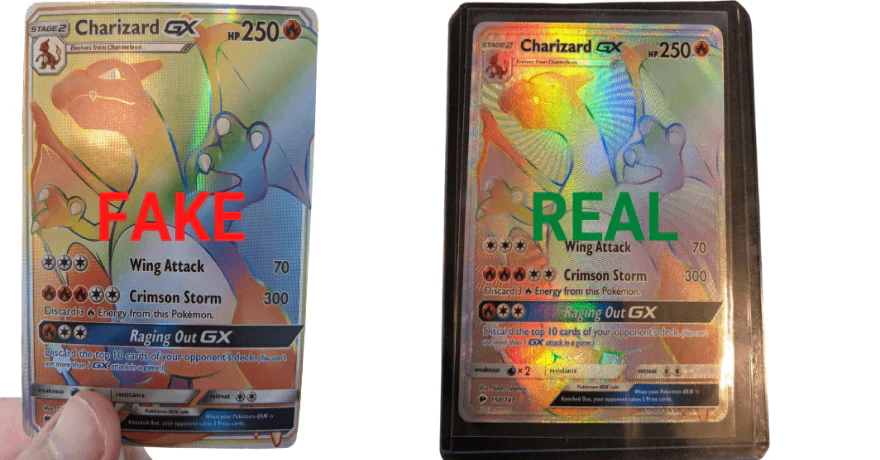
Why Counterfeit Pokémon Cards Exist #
The primary motivation behind counterfeit Pokémon cards is profit.
The demand for rare and valuable cards, combined with the high prices they can fetch, makes the Pokémon card market an attractive target for counterfeiters.
The global popularity of Pokémon means that counterfeit cards can be produced and sold in large quantities, reaching collectors around the world.
Market Demand and High Prices #
As Pokémon cards have become increasingly valuable, particularly first editions, holos, and rare promo cards, counterfeiters have recognized the potential for significant profits.
High-profile sales, such as a first-edition Charizard selling for hundreds of thousands of dollars, have only heightened the interest in producing fakes.
Counterfeiters aim to create cards that look authentic enough to be sold at high prices, often preying on less knowledgeable collectors.
Online Marketplaces and Distribution #
The rise of online marketplaces like eBay, Amazon, and various trading forums has made it easier for counterfeiters to reach a broad audience.
These platforms often have millions of users, providing counterfeiters with a vast pool of potential buyers.
While most marketplaces have policies against selling counterfeit goods, the sheer volume of transactions makes it difficult to catch every fake.
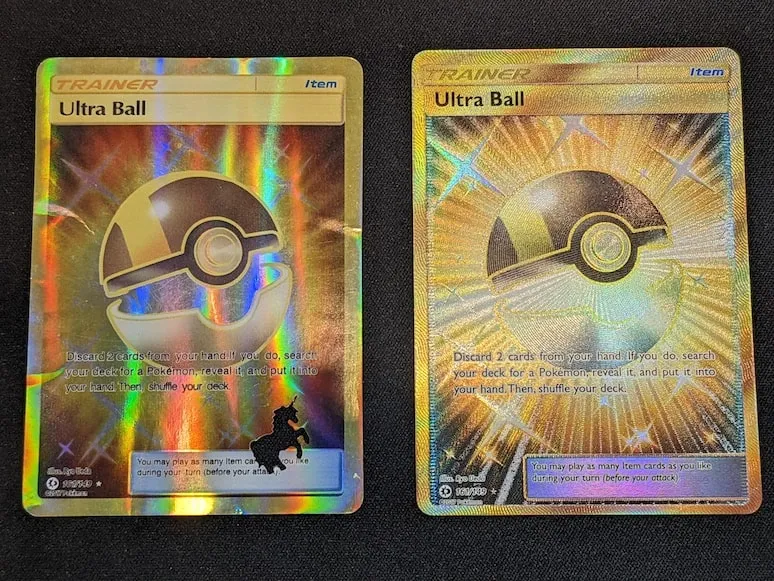
Common Indicators of Fake Pokémon Cards #
Identifying counterfeit Pokémon cards requires a keen eye and attention to detail. Here are some of the most common indicators of fake Pokémon cards, broken down by specific characteristics:
Card Material and Texture #
Genuine Pokémon cards are made from high-quality materials, resulting in a specific weight, thickness, and texture. Counterfeit cards, on the other hand, often use cheaper materials that can feel different in the hand.
Card Weight and Thickness: Authentic Pokémon cards have a consistent thickness and weight. Counterfeit cards may feel too light or too heavy, and their thickness may vary from one part of the card to another. If you suspect a card might be fake, compare it to a known genuine card from the same set to see if the weight and thickness match.
Card Texture: The surface of a real Pokémon card has a specific texture that is smooth but slightly matte. Fake cards may have a glossy or overly smooth finish, which can be a sign that cheaper materials were used. Run your fingers lightly across the card’s surface; if it feels too slick or rough, it could be counterfeit.

Print Quality and Color #
One of the most telling signs of a counterfeit Pokémon card is poor print quality. Genuine Pokémon cards are printed with high-resolution, vibrant colors and precise alignment. Here’s what to look out for:
Text and Font: Authentic Pokémon cards use a specific font and precise text placement. Counterfeit cards often have misaligned text, incorrect font usage, or blurry print. Pay close attention to small text, such as the card’s copyright information, which counterfeiters might overlook.
Color Accuracy: The colors on a real Pokémon card are vibrant and consistent. Counterfeit cards may have faded or overly bright colors. Compare the suspected card with a genuine card from the same set; any color discrepancies could indicate a fake.
Print Clarity: The images and text on an authentic Pokémon card should be sharp and clear. Blurry or pixelated images are a common sign of counterfeiting. This is especially noticeable in the Pokémon’s name, HP, and attack descriptions.
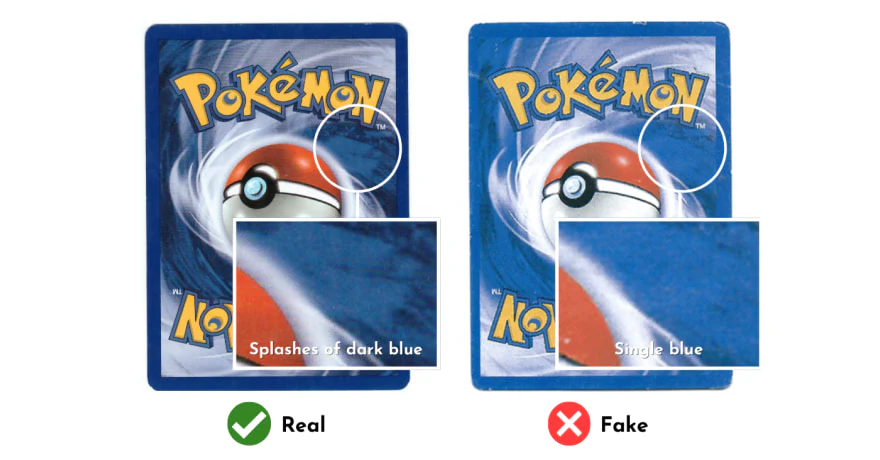
Holographic and Foil Elements #
Many rare and valuable Pokémon cards feature holographic or foil elements, particularly holo cards and certain promos. Counterfeiters often struggle to replicate these effects accurately:
Holo Patterns: On a genuine holographic card, the holo pattern should be smooth and consistent across the surface. Fake cards may have patchy, uneven, or overly reflective holo patterns. Inspect the holo under different lighting conditions; irregularities in the pattern are a red flag.
Foil Quality: The foil on authentic cards is precisely applied and aligned with the card’s design. On counterfeit cards, the foil might be misaligned or extend beyond the intended areas. This is especially noticeable around the card’s edges and any text that overlays the foil.

Back of the Card #
The back of a Pokémon card is often where counterfeiters slip up, making it a crucial area to inspect:
Color Consistency: The back of a real Pokémon card has a specific shade of blue that is consistent across all cards. Fake cards might have a back that is too light, too dark, or with inconsistent coloring. Compare the blue background with a verified card; even a slight difference can indicate a fake.
Poké Ball Design: The design of the Poké Ball on the back of the card should be sharp and centered. Blurry lines, misaligned elements, or off-center designs are common in counterfeit cards.
Edge Alignment: The borders on the back of the card should be even and consistent. If the borders are uneven or if there’s a noticeable tilt to the design, the card is likely counterfeit.

Light Test #
The light test is a simple yet effective method for identifying counterfeit Pokémon cards. Here’s how to perform it:
Hold the Card Up to Light: Take the card in question and hold it up to a bright light source, such as a lamp or flashlight. A genuine Pokémon card is made from high-quality cardstock that is semi-opaque.
Check for Opacity: When held up to the light, a real card should not allow much light to pass through. If you can easily see through the card or if it appears too translucent, it’s likely a counterfeit.
Inspect for Watermarks: Some Pokémon cards, especially older ones, may have a faint watermark or texture that is visible under strong light. Counterfeit cards typically lack these subtle details.
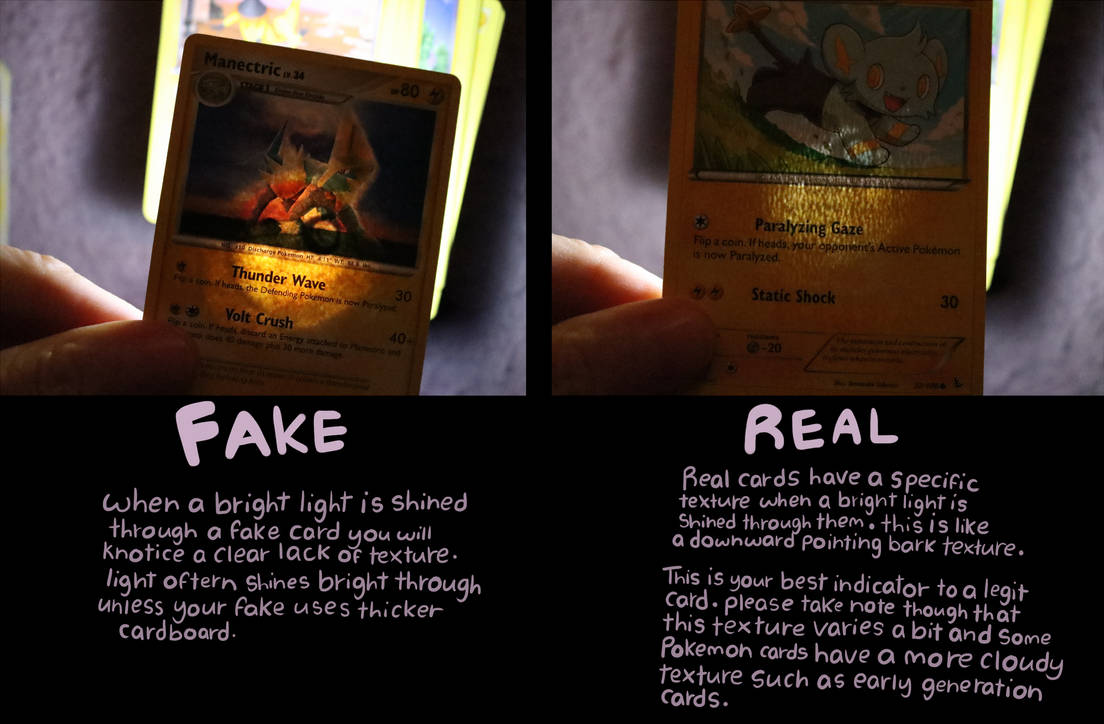
Techniques for Identifying Counterfeit Pokémon Cards #
For higher-value cards or when dealing with sophisticated fakes, basic inspection might not be enough. Here are some advanced techniques you can use to further verify the authenticity of a Pokémon card:
UV Light Test #
Using a UV light (blacklight) can reveal hidden details on Pokémon cards that are difficult to see with the naked eye.
Genuine Pokémon cards often have certain elements that glow under UV light, such as specific parts of the artwork or security features.
Glow Patterns: Shine the UV light on the card and look for any glowing patterns. Compare this with a genuine card from the same set. If the glow patterns differ, the card may be counterfeit.
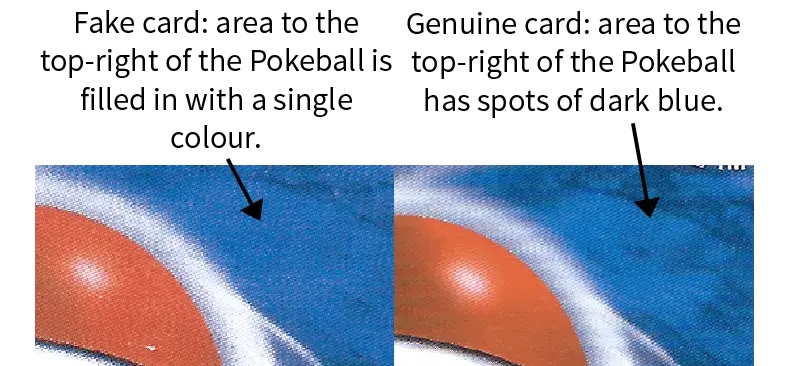
Magnification and Microscopic Inspection #
Sometimes, the differences between real and fake Pokémon cards are too subtle to see with the naked eye.
A magnifying glass or microscope can help you spot these tiny inconsistencies:
Inspecting the Print Dots: Under magnification, the printing on a genuine card should show a clean, uniform pattern of dots. Counterfeit cards may have irregular, overlapping, or inconsistent dot patterns, indicating lower-quality printing methods.
Checking for Microtext: Some genuine Pokémon cards, particularly newer or high-value ones, might include microtext or tiny details that are challenging for counterfeiters to replicate. Use magnification to inspect areas like the copyright text or small elements in the artwork.
Using Third-Party Authentication Services #
For high-value cards, or if you’re unsure about a card’s authenticity, consider using a third-party authentication service.
Companies like PSA (Professional Sports Authenticator) or Beckett Grading Services can authenticate and grade your card, providing peace of mind.
Submission Process: Submit the card to the grading service, where it will undergo a thorough inspection by experts. They’ll assess the card for authenticity and assign it a grade based on its condition.
Certification and Slabbing: If the card is authentic, it will be encapsulated in a tamper-proof case (referred to as “slabbing”) and assigned a certification number. This number is recorded in the service’s database, allowing you to verify the card’s authenticity at any time.

How to Protect Yourself from Buying Counterfeit Pokémon Cards #
Given the prevalence of counterfeit Pokémon cards, it’s essential to take steps to protect yourself when buying cards.
Here are some tips to help you avoid purchasing fakes:
Buy from Reputable Sellers #
When buying Pokémon cards, especially online, always purchase from reputable sellers. Look for sellers with high ratings, positive reviews, and a history of selling genuine products. Be cautious with sellers offering deals that seem too good to be true, as they might be selling counterfeits.
Check Seller Feedback: On platforms like eBay or Amazon, read through the seller’s feedback and reviews. If multiple buyers mention counterfeit products, steer clear.
Request References or Verifications: For high-value cards, ask the seller for references or proof of authenticity, such as a grading certificate from a recognized service.

Request Detailed Photos and Documentation #
If you’re buying a card from an individual or through an online marketplace, ask for detailed, high-resolution photos of the card.
Request close-ups of key areas like the holo pattern, text, and back of the card.
Ask for any documentation that might accompany the card, such as proof of purchase or a grading certificate.
Inspect Photos Carefully: Use the photos to check for any signs of counterfeiting, such as poor print quality or incorrect colors. Compare the photos to known genuine cards from the same set.
Verify Authenticity Certificates: If the card comes with a grading certificate, verify the certificate number with the grading company to ensure it’s legitimate.
Educate Yourself on Pokémon Card Details #
The more you know about Pokémon cards, the better equipped you’ll be to spot fakes.
Familiarize yourself with the characteristics of cards from different sets, including the colors, fonts, holo patterns, and common errors.
Join Pokémon card collecting forums, watch videos from trusted collectors, and keep up with the latest news in the hobby.
Learn About Specific Sets: Each Pokémon card set has unique features that counterfeiters might overlook. Knowing these features can help you spot inconsistencies in counterfeit cards.
Stay Informed on New Counterfeit Techniques: Counterfeiters are constantly improving their methods. Stay informed about new types of counterfeits and the latest trends in the market.
Use Third-Party Verification Services for High-Value Purchases #
If you’re considering purchasing a high-value card, especially from an unfamiliar source, consider using a third-party verification service. These services can authenticate the card before you purchase it, providing peace of mind.
Request a Pre-Purchase Inspection: Some third-party services offer pre-purchase inspections, where they’ll verify the card’s authenticity on your behalf before you complete the transaction.
Use Escrow Services: For particularly high-value transactions, consider using an escrow service that holds the payment until the card’s authenticity is confirmed.
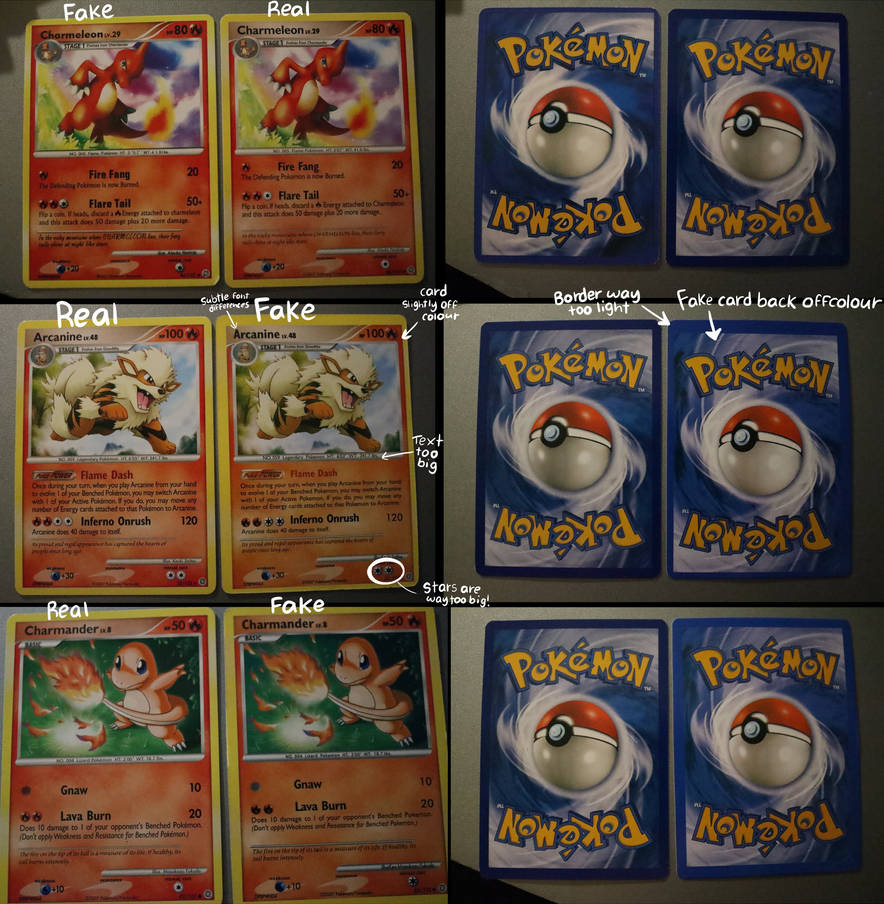 #
#
What to Do If You’ve Purchased a Fake Pokémon Card #
Despite your best efforts, you might still end up purchasing a counterfeit Pokémon card.
If you suspect that you’ve bought a fake, here’s what you should do:
Contact the Seller Immediately #
Reach out to the seller as soon as you realize the card might be fake. Explain your concerns and request a refund or exchange. Many reputable sellers will offer a refund or replacement if the card is proven to be counterfeit.
Document Your Claim: Take detailed photos of the card and compare them to known genuine cards. Provide this evidence to the seller when requesting a refund.
Check Return Policies: Review the seller’s return policies before making your claim. Some sellers might have specific requirements or timeframes for returns.
Report to the Marketplace #
If you purchased the card through an online marketplace like eBay, report the seller to the platform. Most marketplaces have policies against selling counterfeit goods and may take action against the seller. Reporting the counterfeit can help prevent others from falling victim to the same scam.
Submit Evidence: Provide the marketplace with evidence of the counterfeit, including photos and any communication with the seller. This will strengthen your case and increase the likelihood of action being taken.
Leave a Review: Leave a review or feedback warning other potential buyers about the seller. This helps protect the community and reduces the likelihood of others being scammed.
Seek a Chargeback or Dispute Resolution #
If the seller refuses to offer a refund and you paid with a credit card or PayPal, you may be able to initiate a chargeback or dispute resolution.
Contact your payment provider to discuss your options and provide them with evidence that the card is counterfeit.
File a Claim Promptly: Most payment providers have specific timeframes for filing a dispute, so act quickly once you’ve identified the card as fake.
Provide Comprehensive Documentation: Submit all relevant documentation, including photos, communication with the seller, and any expert opinions you’ve obtained.
Educate Others in the Community #
If you’ve encountered a fake card, share your experience with the Pokémon collecting community.
By spreading awareness, you can help others avoid similar pitfalls and contribute to the overall knowledge of the hobby.
Post on Forums and Social Media: Share your experience on Pokémon card collecting forums, Facebook groups, or Reddit communities. Include photos and details about how you identified the counterfeit.
Create a Guide or Video: Consider creating a detailed guide or video explaining how to spot the specific fake you encountered. This can be a valuable resource for other collectors.
By learning how to identify fake Pokémon cards and taking proactive steps when buying, you can protect your collection and investments.
Remember to stay vigilant, buy from trusted sources, and always trust your instincts if something doesn’t seem right.
